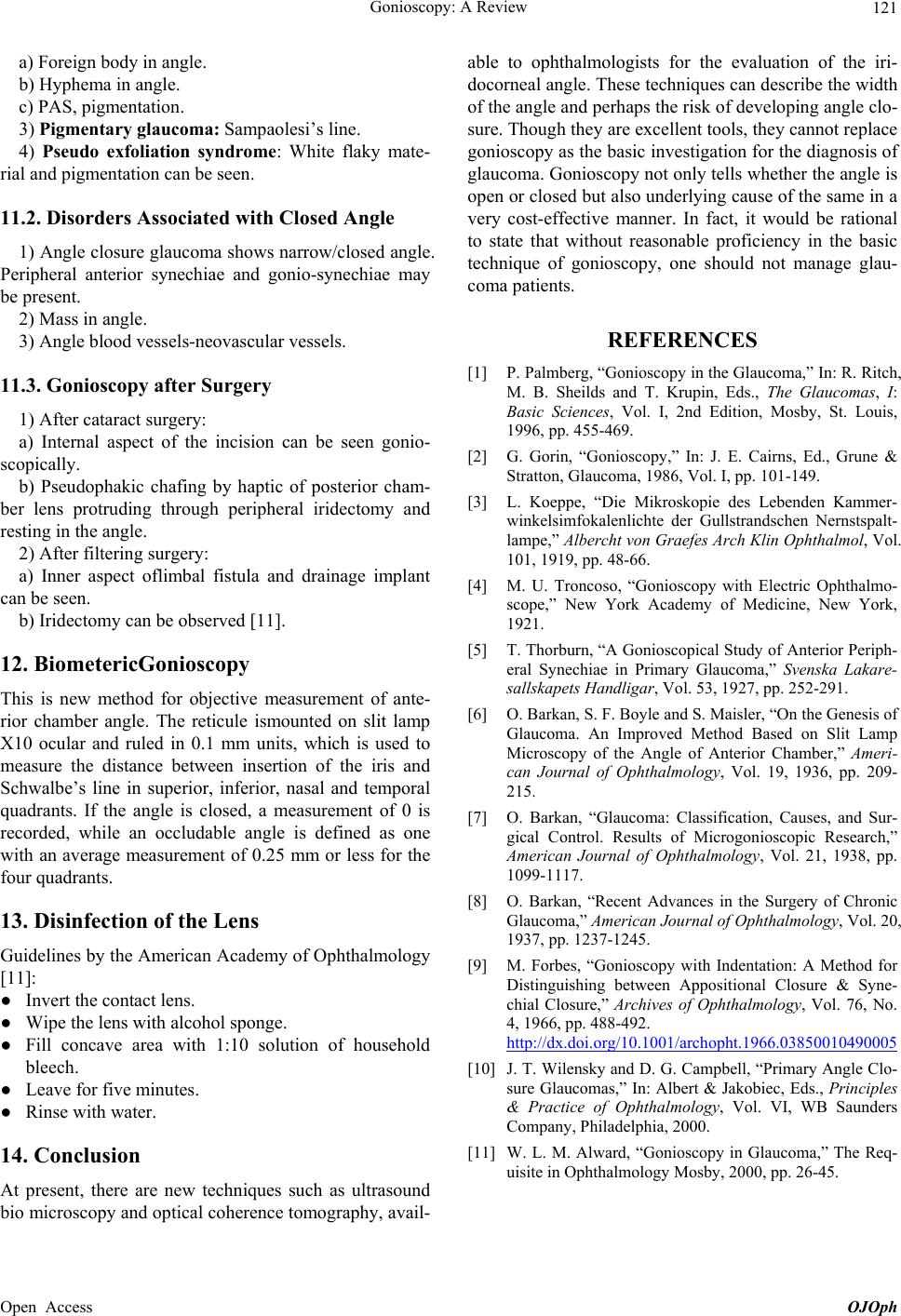
Gonioscopy: A Review
Open Access OJOph
121
a) Foreign body in angle.
b) Hyphema in angle.
c) PAS, pigmentation.
3) Pigmentary glaucoma: Sampaolesi’s line.
4) Pseudo exfoliation syndrome: White flaky mate-
rial and pigmentation can be seen.
11.2. Disorders Associated with Closed Angle
1) Angle closure glaucoma shows narrow/closed angle.
Peripheral anterior synechiae and gonio-synechiae may
be present.
2) Mass in angle.
3) Angle blood vessels-neovascular vessels.
11.3. Gonioscopy after Surgery
1) After cataract surgery:
a) Internal aspect of the incision can be seen gonio-
scopically.
b) Pseudophakic chafing by haptic of posterior cham-
ber lens protruding through peripheral iridectomy and
resting in the angle.
2) After filtering surgery:
a) Inner aspect oflimbal fistula and drainage implant
can be seen.
b) Iridectomy can be observed [11].
12. BiometericGonioscopy
This is new method for objective measurement of ante-
rior chamber angle. The reticule ismounted on slit lamp
X10 ocular and ruled in 0.1 mm units, which is used to
measure the distance between insertion of the iris and
Schwalbe’s line in superior, inferior, nasal and temporal
quadrants. If the angle is closed, a measurement of 0 is
recorded, while an occludable angle is defined as one
with an average measurement of 0.25 mm or less for the
four quadrants.
13. Disinfection of the Lens
Guidelines by the American Academy of Ophthalmology
[11]:
● Invert the contact lens.
● Wipe the lens with alcohol sponge.
● Fill concave area with 1:10 solution of household
bleech.
● Leave for five minutes.
● Rinse with water.
14. Conclusion
At present, there are new techniques such as ultrasound
bio microscopy and optical coherence tomography, avail-
able to ophthalmologists for the evaluation of the iri-
docorneal angle. These techniques can describe the width
of the angle and perhaps the risk of developing angle clo-
sure. Though they are excellent tools, they cannot replace
gonioscopy as the basic investigation for the diagnosis of
glaucoma. Gonioscopy not only tells whether the angle is
open or closed but also underlying cause of the same in a
very cost-effective manner. In fact, it would be rational
to state that without reasonable proficiency in the basic
technique of gonioscopy, one should not manage glau-
coma patients.
REFERENCES
[1] P. Palmberg, “Gonioscopy in the Glaucoma,” In: R. Ritch,
M. B. Sheilds and T. Krupin, Eds., The Glaucomas, I:
Basic Sciences, Vol. I, 2nd Edition, Mosby, St. Louis,
1996, pp. 455-469.
[2] G. Gorin, “Gonioscopy,” In: J. E. Cairns, Ed., Grune &
Stratton, Glaucoma, 1986, Vol. I, pp. 101-149.
[3] L. Koeppe, “Die Mikroskopie des Lebenden Kammer-
winkelsimfokalenlichte der Gullstrandschen Nernstspalt-
lampe,” Albercht von Graefes Arch Klin Ophthalmol, Vol.
101, 1919, pp. 48-66.
[4] M. U. Troncoso, “Gonioscopy with Electric Ophthalmo-
scope,” New York Academy of Medicine, New York,
1921.
[5] T. Thorburn, “A Gonioscopical Study of Anterior Periph-
eral Synechiae in Primary Glaucoma,” Svenska Lakare-
sallskapets Handligar, Vol. 53, 1927, pp. 252-291.
[6] O. Barkan, S. F. Boyle and S. Maisler, “On the Genesis of
Glaucoma. An Improved Method Based on Slit Lamp
Microscopy of the Angle of Anterior Chamber,” Ameri-
can Journal of Ophthalmology, Vol. 19, 1936, pp. 209-
215.
[7] O. Barkan, “Glaucoma: Classification, Causes, and Sur-
gical Control. Results of Microgonioscopic Research,”
American Journal of Ophthalmology, Vol. 21, 1938, pp.
1099-1117.
[8] O. Barkan, “Recent Advances in the Surgery of Chronic
Glaucoma,” American Journal of Ophthalmology, Vol. 20,
1937, pp. 1237-1245.
[9] M. Forbes, “Gonioscopy with Indentation: A Method for
Distinguishing between Appositional Closure & Syne-
chial Closure,” Archives of Ophthalmology, Vol. 76, No.
4, 1966, pp. 488-492.
http://dx.doi.org/10.1001/archopht.1966.03850010490005
[10] J. T. Wilensky and D. G. Campbell, “Primary Angle Clo-
sure Glaucomas,” In: Albert & Jakobiec, Eds., Principles
& Practice of Ophthalmology, Vol. VI, WB Saunders
Company, Philadelphia, 2000.
[11] W. L. M. Alward, “Gonioscopy in Glaucoma,” The Req-
uisite in Ophthalmology Mosby, 2000, pp. 26-45.